St. Anthony of Padua
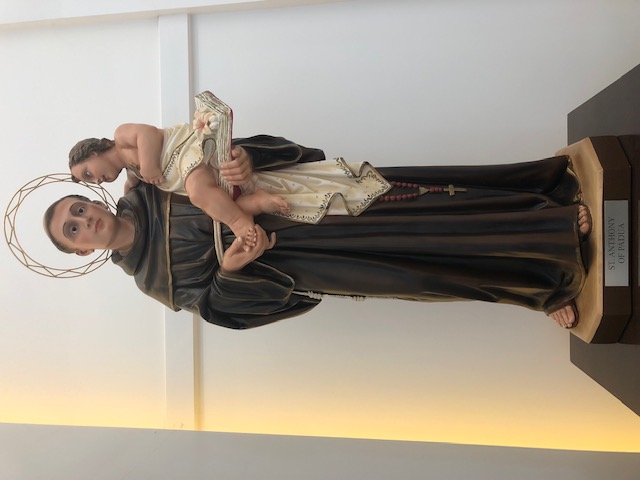
St. Anthony of Padua is the patron saint of the poor and is known for helping find lost items. Originally from a wealthy family in Lisbon Portugal, St. Anthony of Padua was ordained a priest after joining the Order of St. Augustine. His life was forever changed after witnessing the martyred bodies of the first five Franciscan martyrs from Morocco.
After seeing their martyrdom, St. Anthony of Padua left the Augustinians and joined the Franciscan order. He later met St. Francis of Assisi in Sicily. St. Anthony was known for his great preaching ability and humbleness. He traveled over 400 times between Southern France and Northern Italy on preaching missions. St. Anthony died in 1231 and thousands came to his funeral. He was declared a Saint on May 30, 1231 by Pope Gregory IX.
St. Anthony of Padua

San Antonio de Padua es el santo patrón de los pobres y es conocido por ayudar a encontrar objetos perdidos. Fue ordenado sacerdote después de unirse a la Orden de San Agustín en Lisboa, Portugal. Después de presenciar los cuerpos martirizados de los primeros cinco mártires franciscanos de Marruecos, San Antonio de Padua dejó a los agustinos y se unió a la orden franciscana.
San Antonio, más tarde conoció a San Francisco de Asís en Sicilia. San Antonio era conocido por su gran capacidad de predicación y humildad. Viajó más de 400 veces entre el sur de Francia y el norte de Italia predicando el Evangelio. Murió en 1231 miles acudieron a su entierro. El Papa Gregorio IX lo canonizó a menos de un año después de su muerte en Pentecostés el 30 de Mayo de 1231.
San Antonio de Padua
St. Padre Pio of Pietrelcina
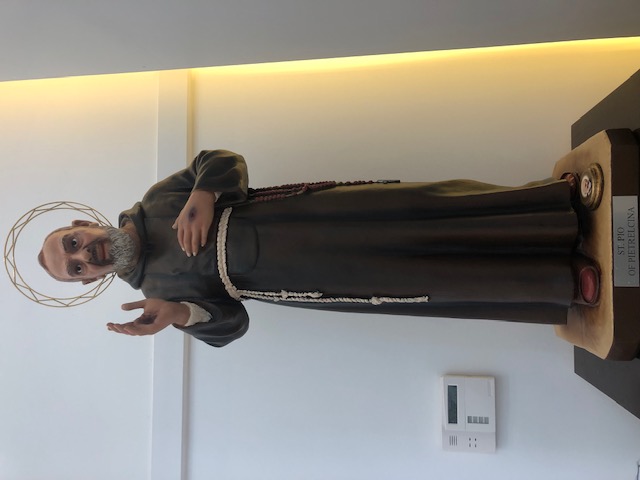
St. Padre Pio is known for performing many miracles and for hearing confessions. He was born on May 25, 1887 and grew up on a farm in southern Italy. He was attracted to the Franciscans and joined the Capuchin friars at the age of 15. He was ordained a priest in 1910 and eventually assigned to the Franciscan friary in San Giovanni Rotondo, Italy.
St. Padre Pio is known for his mystical experiences and his devotion to hearing confessions. One day, while celebrating Mass, he had a vision of Jesus and received the stigmata, or wounds of Jesus. He received the stigmata on his hands, feet and side. After a period of verification, by both Church authorities and medical doctors, the stigmata on his hands, feet and side were authenticated. Padre Pio continued to exhibit the stigmata until his death.
Many people came to see Padre Pio, who heard confessions for almost 10 hours every day. In 1946, after receiving a special inspiration, Padre Pio began construction of a hospital for the sick and suffering on Mount Gargano. Many people today testify to the miracles and healings brought about through the intercession of Padre Pio. St. Padre Pio was beatified on May 2nd, 1999 by Pope John Paul II in Saint Peter’s Square, Vatican City.
St. Padre Pio

San Padre Pío es conocido por realizar muchos milagros y por escuchar confesiones. Después de unirse a los frailes franciscanos, recibió las heridas de Cristo (estigmas) y las heridas permanecieron con él hasta su muerte. Nació el 25 de mayo de 1887 y creció en una granja en el sur de Italia. Se sintió atraído por los franciscanos y se unió a los frailes capuchinos a la edad de 15 años. Fue ordenado sacerdote en 1910 y eventualmente asignado al convento franciscano en San Giovanni Rotondo.
San Padre Pío es conocido por sus experiencias místicas y su devoción por escuchar confesiones. Un día, mientras celebraba la Misa, tuvo una visión de Jesús y recibió los estigmas o heridas de Jesús en sus manos, pies y costado. Después de un período de tiempo, los estigmas fueron verificados tanto por autoridades eclesiásticas como por médicos.
La gente acudía a ver al Padre Pío, quien escuchaba confesiones durante casi 10 horas todos los días. En 1946, después de recibir una inspiración especial, comenzó la construcción de un hospital para los enfermos y los que sufren en el Monte Gargano. Hoy en día, muchas personas dan testimonio de milagros y curaciones gracias a su intercesión. San Padre Pío, fue beatificado el 2 de mayo de 1999 por el Papa Juan Pablo II en la Plaza de San Pedro, Ciudad del Vaticano.
St. Padre Pio
Blessed José Gregorio Hernández
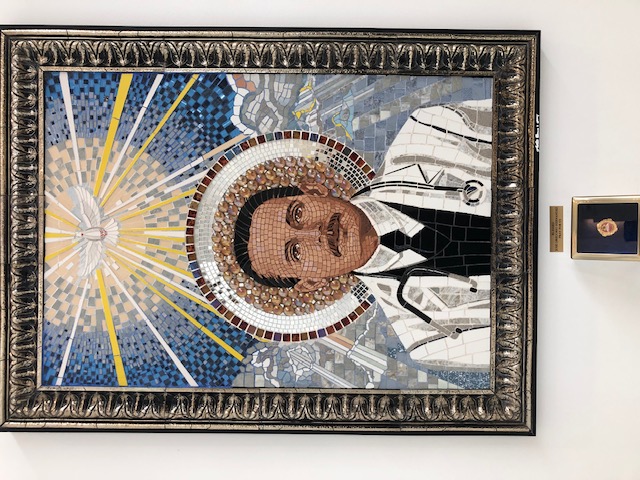
Blessed Jose Gregorio Hernandez is known for the many miraculous healings that occurred through his intercession. He was born in 1864 in Isnotú, a small village in the state of Trujillo in Venezuela. At the age of thirteen, Blessed Gregorio Hernandez was sent to high school in Caracas to the Colegio Villegas where he majored in philosophy. He later studied medicine at the prestigious Universidad Central de Venezuela (UCV). He was a student with an outstanding academic record and graduated from medical school in 1888. He is known for his publications on Bacteriology and philosophy. He tried numerous times to become a priest but was unable to do so because of his poor health.
Blessed Jose Gregorio Hernandez used his own money to buy medicine for the poor and cared for the sick and dying during the Spanish flu in 1918. Jose Gregorio Hernandez died in 1919 after being struck by a car. Numerous miracles and healings have been attributed to his intercession after his death and beatification. A private university in Maracaibo, Venezuela was named after him and is called the Universidad Dr. Jose Gregorio Hernandez. Blessed Gregorio Hernandez was beatified on April 30, 2021
Blessed José Gregorio Hernández

El beato José Gregorio Hernández es conocido por su intercesión en muchas curaciones milagrosas. Nació en 1864 en Isnotú, un pequeño pueblo en el estado de Trujillo en Venezuela. A la edad de trece años, el beato José Gregorio Hernández fue enviado a la escuela secundaria en Caracas al Colegio Villegas donde se especializó en filosofía. Posteriormente, estudió medicina en la prestigiosa Universidad Central de Venezuela (UCV). Fue un estudiante sobresaliente y se graduó de médico en 1888. Es conocido por sus publicaciones sobre bacteriología y filosofía. Intentó en numerosas ocasiones convertirse en sacerdote, pero no pudo hacerlo debido a su mala salud.
José Gregorio Hernández, usaba su propio dinero para comprar medicinas para los pobres y cuidó a los enfermos y moribundos durante la gripe española en 1918. El Beato José Gregorio Hernández murió en 1919 después de ser atropellado por un automóvil. Numerosos milagros y curaciones se han atribuido a su intercesión después de su muerte y beatificación. Una universidad privada en Maracaibo, Venezuela lleva su nombre y se llama Universidad Dr. José Gregorio Hernández. José Gregorio Hernández fue beatificado el 30 de abril de 2021 por el Papa Francisco.
José Gregorio Hernández
St. Francis Xavier Cabrini
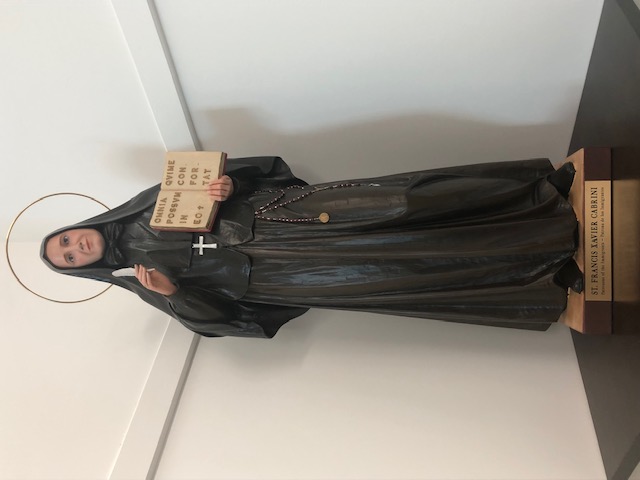
St. Francis Xavier Cabrini is the patron saint of immigrants. She was the Italian born founder of the Missionary Sisters of the Sacred Heart. She was the first United States citizen to be canonized. She made religious work her life’s focus and after taking vows in 1877, she changed her name in honor of St. Francis Xavier, the great missionary. In 1880, she founded the Missionary Sisters of the Sacred Heart which serves orphans. After being directed by Pope Leo XIII to “go west, not east”, Mother Cabrini arrived with a small group of sisters in the United States in 1889. Her order focused primarily on helping poor Italian immigrants here in the United States.
Throughout her 67 years of life, Mother Cabrini founded 67 orphanages, one for each year of her life. At least four miracles have been attributed to Mother Cabrini since her death on December 22, 1917. St. Francis Xavier Cabrini was beatified on November 13, 1938 by Pope Pius XI.
St. Francis Xavier Cabrini

Santa Francisca Xavier Cabrini es la santa patrona de los inmigrantes. Ella fue la fundadora en Italia de las Hermanas Misioneras del Sagrado Corazón. Fue la primera ciudadana estadounidense en ser canonizada. Hizo del trabajo religioso el centro de su vida, y después de tomar los votos en 1877, cambió su nombre en honor a San Francisco Javier. En 1880, fundó las Hermanas Misioneras del Sagrado Corazón que sirven a los huérfanos. Después de que el Papa León XIII le ordenara “ir al oeste, no al este”, la Madre Cabrini llegó con un pequeño grupo de hermanas a los Estados Unidos en 1889. Su orden se centró, principalmente, en ayudar a los inmigrantes italianos pobres de éste país.
A lo largo de sus 67 años de vida, la Madre Cabrini fundó 67 orfanatos. Al menos cuatro milagros han sido atribuidos a la Madre Cabrini desde su muerte el 22 de diciembre de 1917. Santa Francisca Xavier Cabrini fue beatificada el 13 de noviembre de 1938 por el Papa Pío XI.
Santa Francisca Xavier Cabrini
Our Lady of the Mystical Rose
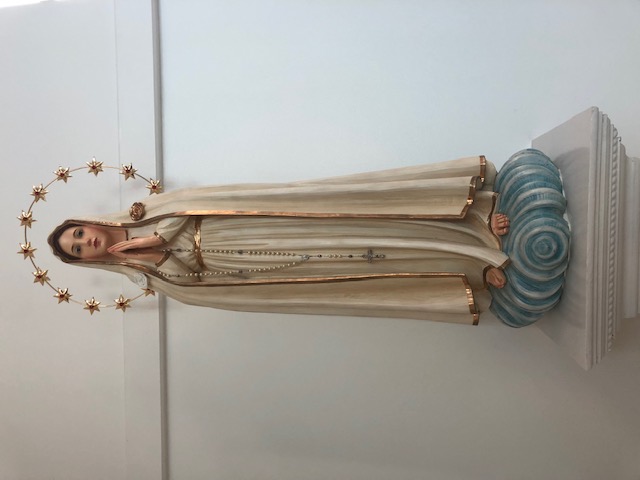
Our Lady of the Mystical Rose is a special devotion to The Blessed Mother that has resulted in many miracles and a greater devotion to priestly and religious life.
Mary is often venerated with roses. This tradition started when Juan Diego offered Bishop Zumarraga a tilma full of roses from Tepeyac Hill. Many years after the apparition of Our Lady of Guadalupe, the Blessed Mother appeared to a nurse named Pierina Gilli in Northern Italy in the town of Montichiari at the foot of the Italian Alps. The first time Mary appeared to Pierina, she appeared with three swords that pierced her breasts. The swords stood for Prayer, Penitence and Expiation.
The second time Mary appeared to Pierina, she had three different colored roses on her breasts, one white, one red and one golden. Mary revealed to Pierina a new Marian devotion to be celebrated on the 13th day of every month. This devotion was known as the devotion to Our Lady of the Mystical Rose. It was specifically for priestly and religious orders. Mary told Pierina that whoever followed this devotion would receive a superabundance of graces, including an increase in vocations.
Our Lady of the Mystical Rose

Nuestra Señora de la Rosa Mística es una especial devoción a La Santísima Madre que ha dado como resultado muchos milagros y una mayor devoción a la vida sacerdotal y religiosa.
La Virgen María es a menudo venerada con rosas. Esta tradición comenzó cuando Juan Diego le ofreció al obispo Zumárraga una tilma llena de rosas del cerro Tepeyac. Muchos años después de la aparición de Nuestra Señora de Guadalupe, la Santísima Madre se apareció en el norte de Italia, en el pueblo de Montichiari al pie de los Alpes italianos a una enfermera llamada Pierina Gilli. La primera vez que se le apareció la virgen tenía tres espadas que le atravesaban el pecho. Las espadas representaban Oración, Penitencia y Expiación.
La segunda vez que se le apareció a Pierina, tenía tres rosas de diferentes colores en su pecho, una blanca, una roja y una dorada. La Virgen María le reveló a Pierina una nueva devoción mariana que se ha de celebrar el día 13 de cada mes. Esta devoción era específicamente para sacerdotes y órdenes religiosas. Nuestra Madre le dijo a Pierina que quien siguiera esta devoción recibiría una sobreabundancia de gracias.
Nuestra Señora de la Rosa Mística
Pope Saint John Paul II

Throughout his life, Pope John Paul II had a tremendous devotion to Our Lady of Guadalupe, who he invoked as “The Patroness of the Americas” and as the Patroness of the New Evangelization. John Paul II, originally named Karol Józef Wojtyła, was born in Wadowice, Poland on May 18th, 1920. His father was a lieutenant in the Polish army and his mother died when he was 8 years old. He was attracted to the priesthood at a young age by Father Kazimierz Figlewicz, the local parish priest who served in the Church next to his father’s apartment. During his years living in Nazi occupied Poland, he worked in a chemical manufacturing plant. He was one of the only Popes who had the experience of being a minimum wage worker. Among his accomplishments was the consecration of the world to the Immaculate Heart of Mary in 1981. Pope John Paul II was known for his teaching on the dignity of the human person and the rights of workers. He was beatified on May 1, 2011.
Pope Saint John Paul II

A lo largo de su vida, el Papa San Juan Pablo II tuvo una gran devoción por Nuestra Señora de Guadalupe, a quien llamó “La Patrona de las Américas” y Patrona de la Nueva Evangelización. San Juan Pablo II, originalmente llamado Karol Józef Wojtyła, nació en Wadowice, Polonia, el 18 de mayo de 1920. Su padre era teniente del ejército polaco y su madre murió cuando él tenía 8 años. Fue atraído al sacerdocio a una edad temprana por el padre Kazimierz Figlewicz, el párroco que servía en la iglesia al lado del apartamento de su padre. Durante los años que vivió en la Polonia ocupada por los nazis, trabajó en una planta de fabricación de productos químicos. Fue uno de los únicos Papas que tuvo la experiencia de ser un trabajador de salario mínimo. Entre sus logros estuvo la consagración del mundo al Inmaculado Corazón de María en 1981. El Papa Juan Pablo II fue conocido por sus enseñanzas sobre la dignidad de la persona humana y los derechos de los trabajadores. Fue beatificado el 1 de mayo de 2011, y canonizado el 27 de abril de 2014 por el Papa Francisco.
Papa San Juan Pablo II
Our Lady of Fatima
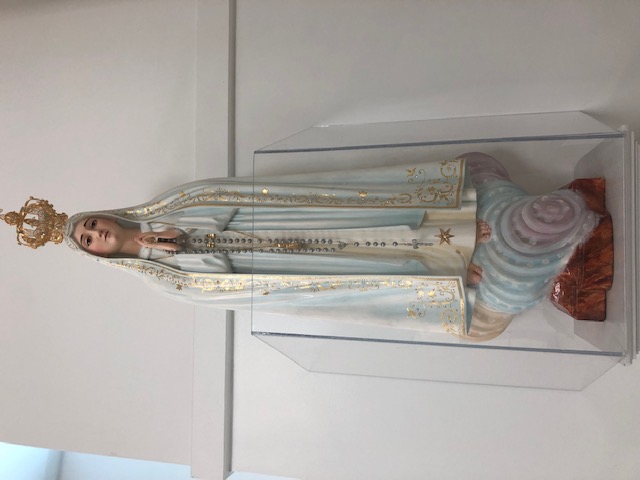
Pope John Paul II had a great devotion to Our Lady of Fatima. Our Lady of Fatima is an apparition of Our Lady to a group of three shepherd children (Lucia, Francisco, and Jacinta) in Fatima, Portugal in 1917. Our Lady appeared to the three children a total of six times and told the children that she was the “Angel of Peace”. Mary appeared, dressed all in white, and urged the children to pray the Rosary daily for an end to war. Mary addressed herself as “The Lady of the Rosary”.
Mary told the children that if people didn’t repent and perform acts of prayer and penance, the world would face many different trials during the twentieth century. The Blessed Mother told the children to promote devotion to the Immaculate Heart of Mary and to offer themselves for the conversion of sinners. One of the many trials revealed by Our Lady of Fatima was the assassination attempt on Pope John Paul II in 1981. Despite predicting many difficulties of the twentieth century, Mary assured the children that “My Immaculate Heart will Triumph”.
Our Lady of Fatima

El Papa Juan Pablo II tenía una gran devoción por Nuestra Señora de Fátima. Nuestra Señora de Fátima es una aparición de la Virgen María a un grupo de tres niños pastorcitos (Lucía, Francisco y Jacinta) en Fátima, Portugal en 1917. Nuestra Señora se les apareció a los tres niños un total de seis veces y les dijo que ella era el “Ángel de la Paz”. María, se mostró toda vestida de blanco, e instó a los niños a rezar el Rosario diariamente por el fin de la guerra y la paz del mundo. María se llamó a sí misma “La Señora del Rosario”.
La Virgen les dijo a los niños que, si la gente no se arrepentía y realizaba actos de oración y penitencia, el mundo enfrentaría muchas pruebas diferentes durante el siglo XX. Nuestra Madre les dijo a los niños que promovieran la devoción al Inmaculado Corazón de María y que se ofrecieran por la conversión de los pecadores. Una de las muchas pruebas reveladas por Nuestra Señora de Fátima fue el intento de asesinato del Papa Juan Pablo II en 1981. A pesar de predecir muchas dificultades, María aseguró a los niños que “Mi Inmaculado Corazón Triunfará”.
Nuestra Señora de Fátima
St. Jude Thaddeus
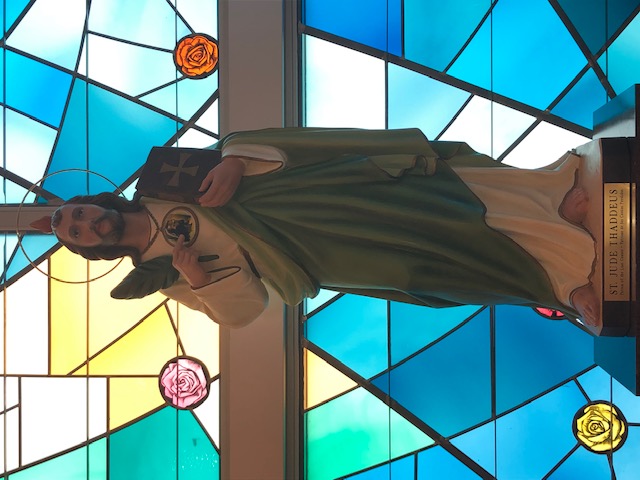
St. Jude is the patron saint of hopeless causes and is known for having performed many miracles. He was a cousin of Jesus and is not to be confused with Judas Iscariot who betrayed Jesus.
St. Jude, also known as Thaddeus, asked Jesus during the Last Supper why Jesus would not reveal Himself to the whole world after His resurrection. There have been many miracles attributed to praying to St. Jude especially in times of difficulty and struggle.
St. Jude Thaddeus

San Judas es el santo patrón de las causas desesperadas y es conocido por haber realizado muchos milagros. Era primo de Jesús y no debe confundirse con Judas Iscariote, quien traicionó a Jesús.
San Judas, también conocido como Tadeo. Después de la Ultima Cena, cuando Cristo prometió que se manifestaría a quienes le escuchasen, San Judas le preguntó por qué no se manifestaba a todos. Cristo le contestó que Él y su Padre visitarían a todos los que le amasen: "Vendremos a él y haremos en él nuestra morada" (Juan, 14, 22-23). No sabemos nada de la vida de San Judas Tadeo después de la Ascensión del Señor y la venida del Espíritu Santo. Se han atribuido muchos milagros a la oración a San Judas, especialmente en tiempos de dificultad y lucha.
San Judas Tadeo
Our Lady of Lourdes
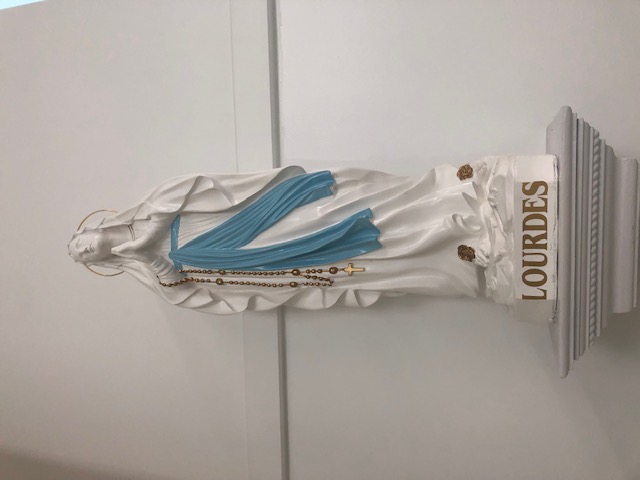
Our Lady of Lourdes is one of the most well-known Marian apparitions. The apparition occurred on February 11 in 1858. Mary appeared to a poor young girl named Bernadette Soubirous while she was out collecting firewood in Southern France. St. Bernadette said that the Lady was praying the Rosary. Bernadette later returned to the grotto and Mary appeared to her again on February 14 and 18. On the day of the third apparition, The Blessed Mother asked Bernadette to return to the grotto every day for two weeks.
During these two weeks of apparitions, Mary asked Bernadette to pray for the conversion of sinners and to have a chapel built in the grotto. She asked Bernadette to drink the spring water coming from the grotto. As a result of the apparitions, St. Bernadette was interrogated by the civil authorities and harassed. In response to such questioning, Bernadette remained strong. Since the time of the apparitions, there have been thousands of miraculous healings that have occurred through the intercession of Our Lady of Lourdes.
Our Lady of Lourdes

Nuestra Señora de Lourdes es una de las apariciones más conocidas de la Santísima Madre. La aparición ocurrió el 11 de febrero de 1858. María se apareció a una joven pobre llamada Bernadette Soubirous mientras recogía leña en el sur de Francia. Santa Bernardita dijo que la Señora estaba rezando el Rosario. Bernardita luego regresó a la gruta y María se le apareció nuevamente el 14 y el 18 de febrero. El día de la tercera aparición, la Santísima Madre le pidió a Bernadette que regresara a la gruta todos los días durante dos semanas.
Durante estas dos semanas de apariciones, María le pidió a Bernardita que orara por la conversión de los pecadores y que hiciera construir una capilla en la gruta. Le pidió a Bernardita que bebiera el agua de manantial que salía de la gruta. Como resultado de las apariciones, Santa Bernardita fue interrogada por las autoridades civiles y hostigada. En respuesta a tales preguntas, Bernadette se mantuvo fuerte. Desde el momento de las apariciones, ha habido miles de curaciones milagrosas que han ocurrido por intercesión de Nuestra Señora de Lourdes.
Nuestra Señora de Lourdes
Mother Teresa
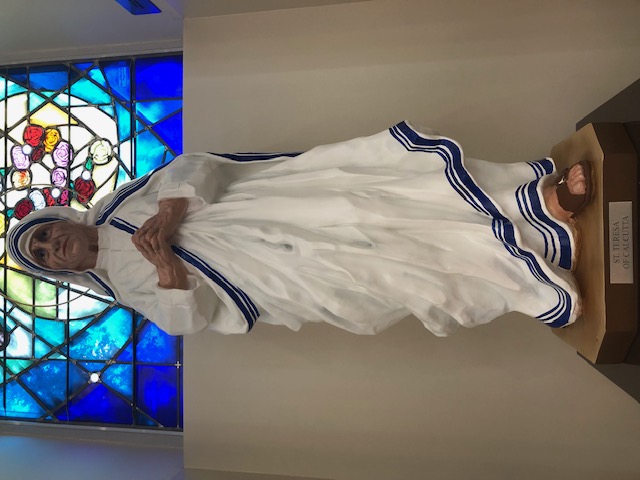
Mother Teresa was known for her work with the poorest of the poor, and she is the founder of the Missionary Sisters of Charity, a religious order that devotes their time to serving the poor. Mother Teresa was born in the capital city of Skopje, Macedonia to Albanian parents. She was born on August 26, 1910. She experienced the call to serve Christ as a religious sister at a young age. One reason for her call to serve the poor was her experience with her own mother.
As a child, the mother of Mother Teresa taught her to never eat unless she was sharing her food with others. This simple teaching would later be integral in the rule of life of the Missionary Sisters of Charity. When Mother Teresa founded the Missionary Sisters of Charity in Calcutta, India in October, 1950, she only had a handful of nuns.
Today, the Missionary Sisters of Charity have grown to over 4500 Sisters worldwide. In response to her work with the poorest of the poor, Mother Teresa was awarded the Nobel Peace Prize in 1979, an award she originally declined but later accepted on the condition that the prize money be given to the poor in India. Mother Teresa died on September 5, 1997 and was canonized a saint on September 4th, 2016.
Mother Teresa

La Madre Teresa era conocida por su trabajo con los más pobres de los pobres, y es la fundadora de las Hermanas Misioneras de la Caridad, una orden religiosa que dedica su tiempo a servir a los pobres. La Madre Teresa nació en la ciudad capital de Skopje, Macedonia de padres albaneses, el 26 de agosto de 1910. Desde muy joven experimentó el llamado a servir a Cristo como religiosa. Una de las razones de su llamado a servir a los pobres fue la experiencia con su propia madre.
Cuando era niña, su la madre le enseñó a nunca comer a menos que estuviera compartiendo su comida con otros. Esta enseñanza se incluiría más tarde en la regla de vida de las Hermanas Misioneras de la Caridad. Cuando la Madre Teresa fundó las Hermanas Misioneras de la Caridad en Calcuta, India, en octubre de 1950, sólo tenía un puñado de monjas.
Hoy, las Hermanas Misioneras de la Caridad tienen más de 4500 Hermanas en todo el mundo. La Madre Teresa murió el 5 de septiembre de 1997 y fue canonizada como santa el 4 de septiembre de 2016.
La Madre Teresa
Our Lady of Mount Carmel
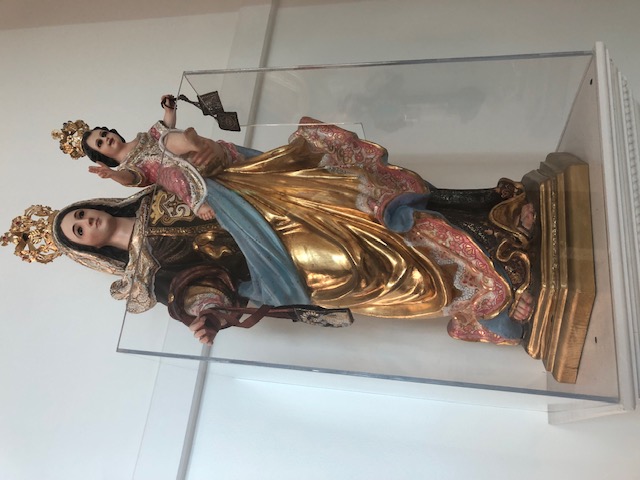
On Sunday July 16, 1251, Mary appeared to St. Simon Stock, a hermit living with the Carmelite Order on Mount Carmel in Israel. Mary appeared to him holding the Christ child and a brown scapular. Since then, the devotion of wearing a brown scapular has spread. The devotion is specific to the Carmelite Order and was given to them by the Blessed Mother.
To obtain the benefits of wearing the brown scapular it is necessary to live a holy life. In addition, three conditions need to be met: 1. Wear the Brown Scapular 2. Observe chastity according to one’s state in life. 3. Pray the Rosary. Also, in order to obtain the full effects of wearing the scapular, one needs to formally enter the order of the Brown Scapular through a qualified priest or lay person who has been given this ability. All scapulars should be blessed by a priest or deacon before wearing.
Our Lady of Mount Carmel

El domingo 16 de julio de 1251, La Virgen María se apareció a San Simón Stock, un ermitaño que vivía con la Orden Carmelita en el Monte Carmelo en Israel. María se le apareció sosteniendo al niño Jesús y un escapulario marrón. Desde entonces, se ha extendido la devoción de llevar un escapulario marrón. La devoción es específica de la Orden Carmelita y les fue dada por la Santísima Madre.
Para obtener los beneficios de usar el escapulario marrón, se deben cumplir tres condiciones: 1. Usar el escapulario marrón 2. Observar la castidad de acuerdo con el estado de vida de cada uno. 3. Rezar el Rosario. Además, para obtener los efectos completos de usar el escapulario, uno debe ingresar formalmente a la orden del Escapulario Marrón a través de un sacerdote o laico a quien se le ha otorgado esta habilidad. Todos los escapularios deben ser bendecidos por un sacerdote o diácono antes de usarlos.
La Virgen del Carmen
St. Joseph
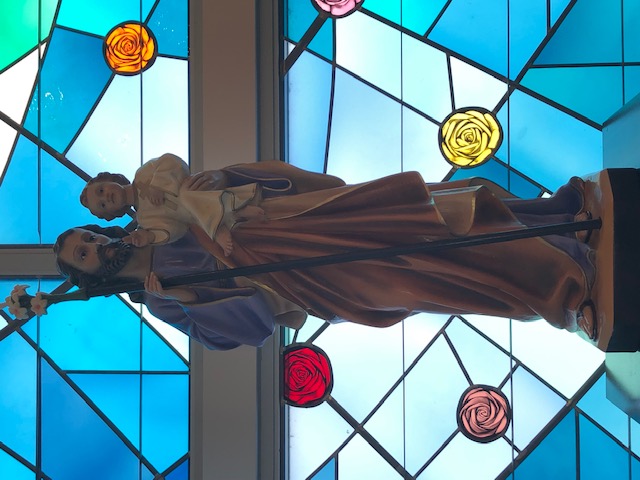
St. Joseph was the earthly father of Jesus and chaste spouse of the Blessed Mother. He was the protector of the Holy Family and is the guardian of family life. He is the patron saint of the Universal Church, families, fathers, workers, expectant mothers, house sellers and engineers. His protection is invaluable and many people have experienced miracles through his intercession.
God entrusted St. Joseph with caring for His only Son and with taking care of Mary. This makes him the patron saint of fathers. Through his flight to Egypt from Nazareth, St. Joseph experienced what it was like to flee one’s home country and live in a foriegn land. This makes him the patron of immigrants and their families. His feast day is celebrated every year on March 19th.
St. Joseph

San José fue el padre terrenal de Jesús y esposo casto de la Santísima Madre. Era el protector de la Sagrada Familia y es el guardián de la vida familiar. Es el patrón de la Iglesia Universal, de las familias, de los padres, de las futuras madres, de los vendedores de casas y de los ingenieros. Su protección es invaluable y muchas personas han experimentado milagros al rezarle.
Dios encomendó a San José el cuidado de Su único Hijo y el cuidado de La Virgen María. Esto lo convierte en el santo patrón de los padres. A través de su huida a Egipto desde Nazaret, San José experimentó lo que era escapar de su país de origen y vivir en una tierra extranjera. Esto lo convierte en el patrón de los inmigrantes y sus familias. Su fiesta se celebra cada año el 19 de marzo.